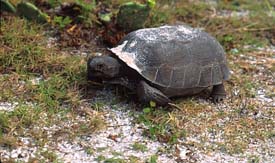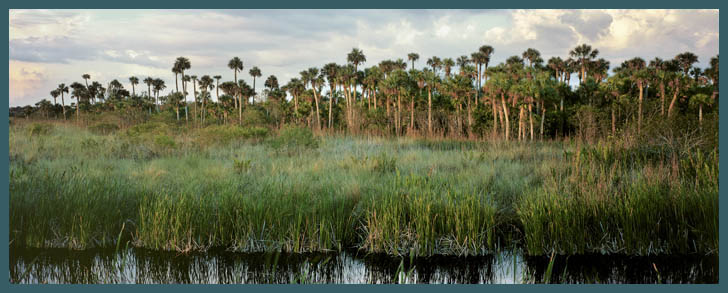|
Gopher Tortoises
Did you know that the Gopher Tortoise, Gopherus polyphemus, is Florida's only true tortoise as well as being labeled the state tortoise and is the only native tortoise living east of the Mississippi? It belongs to a group of land tortoises that originated in North America 60 million years ago, making it one of the oldest living species. Their skin color ranges from light to grayish or dark brown, as is its carapace "shell", although their upper shell is yellowish brown in color. The slow-moving tortoise can grow to as much as 14.6 inches in length, and weigh roughly 29 pounds. Their shorter hind legs are reminiscent of those of an elephant; however, their long front legs with sharp claws are for burrowing. They are also incapable of swimming.
 Amazingly, gopher tortoises can dig burrows up to 16 feet deep and 30 feet in length. Normally, the width of the hole is a fairly good indicator of the size of the tortoise living in the burrow. This burrow is intended to provide the tortoise with shelter - from the weather as well as other predators, but often their empty burrows end up providing shelter for other animals, such as rabbits, gopher frogs, armadillos, field mice, even skunks and snakes. Other larger mammals have been known to enlarge these burrows for their own nests. According to my research, each tortoise may dig several burrows within its home range over the course of his lifetime and live there safely for many decades. The gopher tortoise is considered a "keystone species" because the burrows they dig actually provide shelter for some 300+ other species of animals previously mentioned above.
Amazingly, gopher tortoises can dig burrows up to 16 feet deep and 30 feet in length. Normally, the width of the hole is a fairly good indicator of the size of the tortoise living in the burrow. This burrow is intended to provide the tortoise with shelter - from the weather as well as other predators, but often their empty burrows end up providing shelter for other animals, such as rabbits, gopher frogs, armadillos, field mice, even skunks and snakes. Other larger mammals have been known to enlarge these burrows for their own nests. According to my research, each tortoise may dig several burrows within its home range over the course of his lifetime and live there safely for many decades. The gopher tortoise is considered a "keystone species" because the burrows they dig actually provide shelter for some 300+ other species of animals previously mentioned above.
Gopher tortoises are considered herbivore scavengers, and their diets consist of a wide range of plants, grasses and terrestrial legumes. They have also been known to eat fruits such as blackberries and saw palmetto berries, in addition to mushrooms.
While both sexes are similar in general appearance and color, one difference between them is their plastron - the shell on the underside of the body - which is flat in females and slightly concave in males. Gopher tortoises are said to have the lowest reproductive potential of turtles studied. The females become sexually mature anywhere between their tenth and fifteenth year. She will lay about six eggs per year in a nest below ground, and incubation lasts about 90 days, with the eggs hatching in either August or September. Sadly, less than 6% of eggs are expected to reach even the first year or more after hatching, due to the numerous predators such as raccoons, foxes, armadillos, skunks and even alligators. The sex of the eggs is determined by the temperature while incubated below the sand. If the sand is over 30 degrees Celsius the hatchlings will be female, and those below 30 degrees Celsius will be male. Hatchlings shells are more yellowish in color but will take on a darker color as they age. Gopher tortoises have been known to live 40 years and upwards.
Gopher Tortoises are currently listed as a threatened species here in Florida. According to the Calusa Herpetological Society of Southwest Florida, "no person shall buy, sell, take or possess any gopher tortoise, or any part thereof, except by permit from the Fish and Wildlife Conservation Commission (FWC) executive director. Possession of gopher tortoises may be authorized by permit when the owner can demonstrate that such tortoise(s) were legally acquired and possessed before July 1, 1988." Due to their "keystone species" status, it stands to reason that conservation efforts focusing on the gopher tortoise will also aid these other species as well.
There are five known major threats to the tortoise population that include: habitat loss through human development - their biggest threat, since they like the high and dry upland areas; humans themselves wanting either to keep the tortoise as a pet or to consume it; habitat loss through poor supervision; and just as important are relocation efforts during construction development, which will unknowingly cause a population disruption, as well as invite possible diseases caused by the relocation efforts. It has been proven that relocation of any means has drastically reduced the historic range of the tortoise; and the tortoises themselves can't help with these numbers due to their own lengthy maturity and low reproductive rates. Were you aware that people have eaten gopher tortoises for literally thousands of years? My research stated that during the Great Depression, the gopher tortoise was known as the "Hoover Chicken" because they were eaten by those poor people who were out of work. While it is illegal to hunt gopher tortoises today or even to possess their meat or shells, with some seeing their meat as a delicacy, illegal hunting still continues, at an unsustainable rate, pushing them to near extinction. Keep in mind too, many tortoises are killed annually by cars and trucks on our open highways and these roads themselves further isolate the tortoise colonies.
Knowing that the long-leaf ecosystem is needed for the maintenance of the gopher tortoise, it is imperative that conservation efforts begin to maintain this endangered ecosystem itself. This long-leaf pine ecosystem provides extreme conditions including "sandy sites" for the tortoise's habitation as well as "nutrient" deprived soil. While a long-leaf pine tree can live to over 300 years, it initially takes anywhere from 100 to 150 years for the long-leaf pine to grow! Conserving these forests goes hand in hand with the protection of the gopher tortoises.
Lastly, on the local front, I once again checked with my "authority" friend Renee at Rookery Bay National Estuarine Research Reserve for additional information. She confirmed that we do indeed have gopher tortoises here in Collier County in numerous places, such as Barefoot Beach in North Naples, the Naples Preserve near the Coastland Mall, Shell Island Road and Key (Keewaydin) Island within the Rookery Bay Reserve, as well as Marco Island. Renee went on to state that, "coastal scrub is the ideal habitat for these gopher tortoises and one that is shrinking statewide because of its desirability for construction." You'll be pleased to know that Rookery Bay is preparing a gopher tortoise habitat/live exhibit outside the Estuarine Learning Center that will open this fall...watch for this notice in the newspapers, or call them at 239-417-6310.
END
The ABCs of the Florida Landscape is written by freelance writer Maureen Sullivan-Hartung who has resided in Naples for 30 years now and loves learning about all aspects of the local flora and fauna. Another passion of hers is local history and she authored a book in November 2010, titled, Hidden History of Everglades City & Points Nearby, published by The History Press. Check her website for the book's availability or additional information about the author at www.maureenwrites.com.
msh72011
Check out these websites for information on how to support or help these threatened tortoises:
www.gophertortoise.org
www.myfwc.com
Plus, check out these books for additional information on the Gopher Tortoise:
At Home with the Gopher Tortoise: The Story of a Keystone Species by Madeleine Dunphy, 2010, children's ages 4-8
Florida's Fabulous Reptiles & Amphibians photographed by Pete Carmichael and Winston Williams, 1999
Gopher Tortoises (The Library of Turtles and Tortoises) by Christopher Blomquist, 2004, children's ages 4-8
The Gopher Tortoise: A Life History (Life History Series) by Ray E. Ashton, 2004
The Gopher Tortoise (Endangered and Threatened Animals) by Donald G. Schueler, 2003
|

